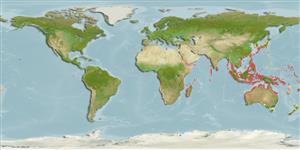>
Blenniiformes (Blennies) >
Blenniidae (Combtooth blennies) > Salariinae
Etymology: Istiblennius: Greek, istios = sail + Greek, blennios = mucus (Ref. 45335).
Eponymy: Jean-Jacques Dussumier (1792–1883) was a French merchant, collector, traveller and ship owner. [...] (Ref. 128868), visit book page.
More on author: Valenciennes.
Environment: milieu / climate zone / intervalo de profundidade / distribution range
Ecologia
marinhas; estuarina associadas(os) a recifes; intervalo de profundidade 0 - 3 m (Ref. 86942). Tropical
Indo-West Pacific. East Africa to Fiji, north to Taiwan, south to the Norfolk Island.
Tamanho / Peso / Idade
Maturidade: Lm ? range ? - ? cm
Max length : 12.0 cm TL macho/indeterminado; (Ref. 2334)
Descrição breve
Chaves de identificação | Morfologia | Morfometria
Espinhos dorsais (total) : 12 - 14; Raios dorsais moles (total) : 19 - 24; Espinhos anais: 2; Raios anais moles: 21 - 25. Dark spot distally between 1st 2 dorsal spines; (Ref. 4404). Males with about 6 dusky bands on body; females with bands that tend to form vertical rows of dusky spots; dusky spots on dorsal and caudal fins; anal fin uniformly dusky (Ref. 4404).
Body shape (shape guide): elongated; Cross section: oval.
Facultative air-breathing (Ref. 126274); Euryhaline. Adults are often found in mangrove areas (Ref. 9962). They inhabit sheltered rocky shorelines and mangroves (Ref. 37816). Oviparous. Eggs are demersal and adhesive (Ref. 205), and are attached to the substrate via a filamentous, adhesive pad or pedestal (Ref. 94114). Larvae are planktonic, often found in shallow, coastal waters (Ref. 94114).
Life cycle and mating behavior
Maturidade | Reprodução | Desova | Ovos | Fecundidade | Larvas
Oviparous, distinct pairing (Ref. 205).
Springer, V.G. and J.T. Williams, 1994. The Indo-West Pacific blenniid fish genus Istiblennius reappraised: a revision of Istiblennius, Blenniella, and Paralticus, new genus. Smithson. Contrib. Zool. 565:1-193. (Ref. 9962)
Categoria na Lista Vermelha da IUCN (Ref. 130435: Version 2025-1)
Ameaça para o homem
Harmless
Utilização humana
Pescarias: sem interesse
Ferramentas
Relatórios especiais
Descarregue XML
Fontes da internet
Estimates based on models
Preferred temperature (Ref.
123201): 23.1 - 29.3, mean 28.5 °C (based on 2688 cells).
Phylogenetic diversity index (Ref.
82804): PD
50 = 0.5001 [Uniqueness, from 0.5 = low to 2.0 = high].
Bayesian length-weight: a=0.00776 (0.00356 - 0.01695), b=3.00 (2.81 - 3.19), in cm total length, based on LWR estimates for this (Sub)family-body shape (Ref.
93245).
Nível Trófico (Ref.
69278): 2.0 ±0.00 se; based on food items.
Resiliência (Ref.
120179): Elevada, tempo mínimo de duplicação da população menor que 15 meses (Preliminary K or Fecundity.).
Fishing Vulnerability (Ref.
59153): Low vulnerability (10 of 100).
🛈
Nutrients (Ref.
124155): Calcium = 153 [66, 272] mg/100g; Iron = 0.793 [0.431, 1.467] mg/100g; Protein = 18.2 [17.0, 19.4] %; Omega3 = 0.0743 [, ] g/100g; Selenium = 16.7 [7.3, 39.3] μg/100g; VitaminA = 103 [26, 392] μg/100g; Zinc = 3.01 [1.92, 4.68] mg/100g (wet weight);
